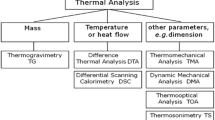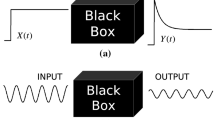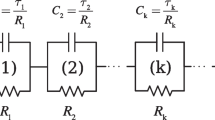Abstract
Two new terms for the critical classification and selection of measuring points in spectrochemical multicomponent analysis are introduced: the distension ϑ and the distension of the system Θ = ¯ϑi. Both terms give a quantitative relation of the selectivity of any single point of a spectrum with respect to the others and incorporate a measure of the overall-distension of a system. The distension allows the optimal reduction of a multiple overdetermined system and the optimal selection of the best points to be taken from a continuously measured spectrum. Procedures for the calculation of Θ and for the optimization which follows are given and demonstrated.
The angle-dependent Θ-optimization is preceded by an “length-discriminating” preselection of points of a continuously measured spectrum; this is done by comparing the difference spectra of all compounds with respect to the sum spectra.
Zusammenfassung
Für die objektive Beurteilung und Auswahl von Meßpunkten aus überbestimmten spektrometrischen Vielkomponentensystemen werden als Bewertungskriterien die neuen Begriffe der Distension ¯ϑ und der Systemdistension Θ = ¯ϑi eingeführt. Beide geben ein quantitatives Maß der Selektivität einzelner Meßstellen in Relation zu den übrigen bzw. mit ihrem Mittelwert Aussagen über die Distension Θ eines Mehrkomponentensystems. Die Distension Θ erlaubt die optimale Reduzierung eines mehrfach überbestimmten Systems und somit auch die Auswahl optimaler Meßpunkte eines zunächst kontinuierlich vermessenen Systems. Rechenverfahren zur Bestimmung der Distension und der anschließenden Optimierung überbestimmter Systeme werden angegeben und an Beispielen erläutert.
Ergänzt wird die Θ-Optimierung durch eine „längendiskriminierende“ Vorauswahl von geeigneten Meßpunkten aus kontinuierlichen Spektren durch Maximierung der Differenzspektren gegenüber den Summenspektren der übrigen Gemischkomponenten.
Der Unterschied der Θ-Optimierung zur Empfindlichkeitsoptimierung wird diskutiert.
Similar content being viewed by others
Literatur
Herschberg, F. S.: diese Z. 205, 180 (1964)
Junker, A., Bergmann, G.: diese Z. 272, 267 (1974)
Kaiser, H.: diese Z. 260, 252 (1972)
Kaiser, H.: In: Methodicum Chimicum, Bd. I/1. Hrsg.: F. Korte. 1. Kapitel. Stuttgart: G. Thieme 1973
Kienitz, H.: diese Z. 164, 80 (1958)
Lübbers, D. W., Niesel, W.: Naturwissenschaften 44, 59 (1957)
Lübbers, D. W., Wodick, R.: Appl. Optics 8, 1055 (1969)
Neuer, H.: diese Z. 253, 337 (1972)
Sternberg, J. C., Stillo, H. S., Schwendemann, R. H.: Anal. Chem. 32, 84 (1960)
Author information
Authors and Affiliations
Rights and permissions
About this article
Cite this article
Junker, A., Bergmann, G. Auswahl, Vergleich und Bewertung optimaler Arbeitsbedingungen für die quantitative Mehrkomponenten-Analyse. Z. Anal. Chem. 278, 191–198 (1976). https://doi.org/10.1007/BF00447581
Received:
Issue Date:
DOI: https://doi.org/10.1007/BF00447581




